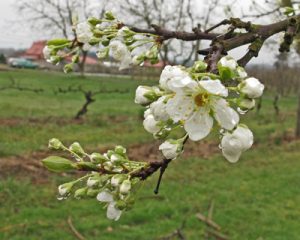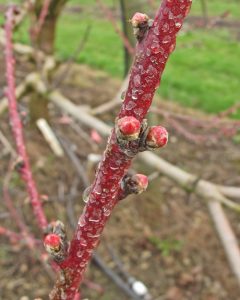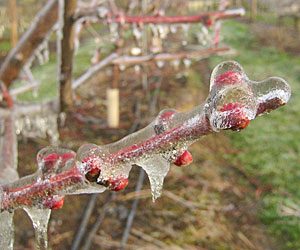It is now the last week of February, and throughout Whatcom County, we are seeing early plums in bloom, buds on cherries and peaches swelling, and even pears showing signs of waking up. Should we be worried?
Here at Cloud Mountain
Our greatest fear is that the skies clear during cold weather. All fruit trees have different degrees of hardiness in their fruit buds as they come out of dormancy. Most fruit buds on trees that are fully dormant are hardy down to single digits. But once the trees begin coming out of dormancy, and the buds begin to swell, those buds become less hardy.
For commercial orchards, watching bud stages and weather can be intense. We know from much research what the critical bud damage stage is for many types of fruit trees. For these Japanese plum blossoms, we know that 28F can mean a 10% loss of fruit on the tree at this blooming stage. If the temperatures should drop to 23F, we’ll lose most of the fruit. These plums in a good year can bring us revenue of over $400 per tree in fruit sales, so you can see why an early spring can have us worried!
- Japanese Plum in Bloom
- Peach Buds
- Ice coated peach buds
Our peaches are at pink bud stage, and critical temperature for them is 25F. Below that, and we start losing significant fruit.
We’re not as worried about pears and apples, although both are coming out of dormancy. Right now, our pears and apples could take 15F with only slight damage.
This last weekend of February, we’re seeing a chance of frost, even in the milder parts of our county. Knowing the patterns this time of year, and a forecast for Saturday night of 29F, we anticipate that our temperatures could drop to 25F or lower. We’re beginning to strategize about how to protect those plum blossoms.
One way we have prevented freeze damage in the past is to coat the trees with water as the air freezes. Water changing phase to ice releases some heat into the air. The buds inside the ice do not drop much below freezing. This works if our irrigation system is turned on, so we can put micro sprinklers high in the trees.
In the past, orchardists would burn ‘smudge pots’ or small stoves in their orchards to heat the air. In modern days, in the fruit growing regions of eastern Washington, propane fired wind machines move the air around to keep frost from forming on the trees.
What you can do at home
For the backyard orchardist, running a mist type sprinkler high in your trees may help save your fruit if cold nights threaten. Another strategy that works if power is available is to string Christmas lights along the branches (not LED). The tiny bulbs give off enough heat to keep the blossoms warm.
Even if we do get hard freezes that damage our fruit crops, it is important to remember that only the fruit crop is damaged; the trees will be fine. Growing fruit trees is a long term proposition, and in some years the crop will be lighter than others….sometimes due to an awesomely sunny winter.




